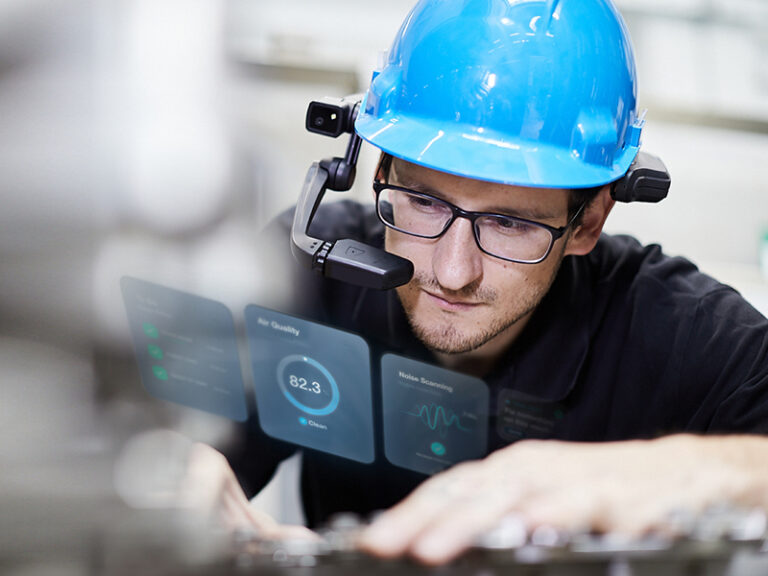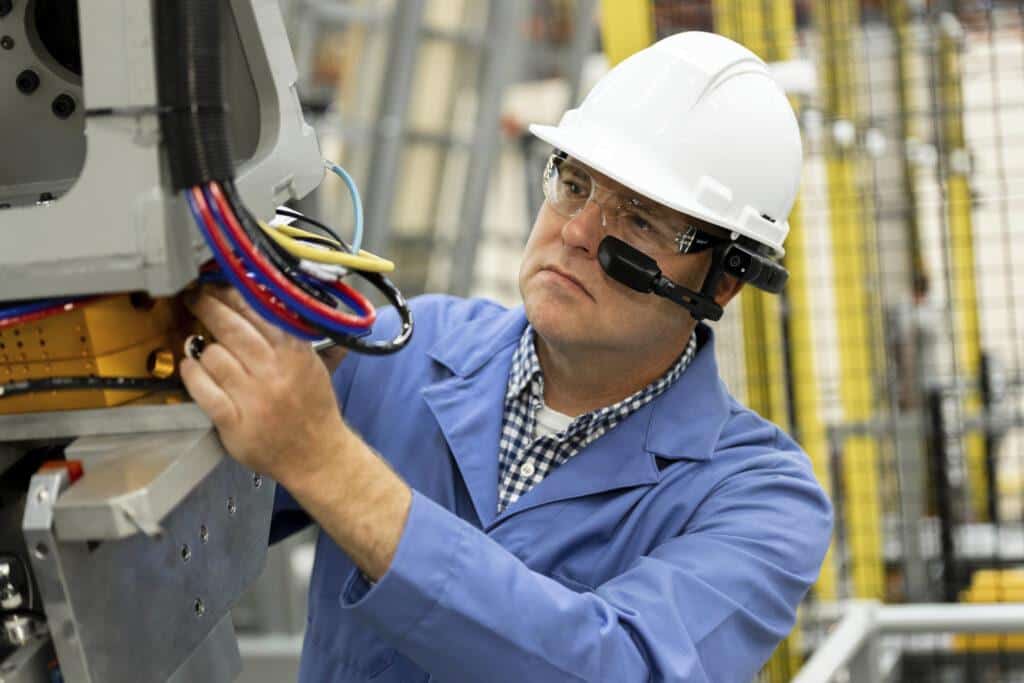Among the
innovative technologies
of the latest generation, augmented reality glasses or smart glasses offer the wearer the ability to work better by obtaining various useful information about the surroundings and the task at hand.
In fact, with the help of images, video, audio and other relevant data, AR viewers store information needed to reduce human error and perform, for example, precision work at a distance.
Let’s find out about their origins and why since entering the market they first proved to be a flop, and then became a valuable support in the way of work.
Sommario
- 1 What is augmented reality
- 2 History of augmented reality and smart glasses
- 3 Experience now the potential and functionality of assisted reality for your work.
- 4 1990 to 2000
- 5 From 2000 to the present day
- 6 REQUEST A NO-OBLIGATION DEMO
- 7 Smart glasses and the world of work: great potential
- 8 The three key benefits of RealWear visors for augmented reality:
- 9 What do RealWear smart glasses do?
- 10 Goals and results of RealWear’s augmented reality license plate
- 11 REALWEAR NAVIGATOR 500
- 12 About Fastbrain and why to choose it
- 13 Contact us for a free consultation
What is augmented reality
Augmented reality or augmented reality is the architecture that oversees smart glasses and takes advantage of mobile device displays that essentially become “interactive storefronts,” precisely through the use of multimedia information.
AR is a technology to “expand” the real world with virtual objects: the superimposition of certain elements-applications-data-images-video-audio-to the real world, “enhances the vision” of the wearer.
“Smart glasses” fall under wearable devices, i.e., wearable devices that are used to obtain information useful for the task at hand.
We have explored this topic in depth in this article.
But when do we start talking about augmented reality?
History of augmented reality and smart glasses
To retrace the concept of augmented reality, we need to start more than a century ago.
In fact, it dates back to 1901 a story told by writer Frank L. Baum in The master Key, about a young boy who, by wearing special glasses, is able to discover the “moral” qualities of people: goodness, badness, stupidity or intelligence.
All, by means of markers – character markers – placed on the forehead (G for Good, E for Evil – for example) of the subject and glasses that look like the forerunners of Google glasses or Microsoft’s Hololens.
Fun fact: Video games will be made in 2007 –
The Eye of Judgement for PS3
– that will use just markers and augmented reality to conjure characters and functional elements to the game.
Fantasy aside, it was in 1966 that the first prototype wearable devices were built, by American scientist and computer scient ist Ivan Edward Sutherland.
These prototypes consist of a helmet equipped with visors that returns a three-dimensional image. Such a device adds nothing to the reality around it but offers a synthetic version of it.
The definition of this mode of viewing is therefore “mediated reality” and not yet “augmented.”

Experience now the potential and functionality of assisted reality for your work.
Book a demo now1990 to 2000
We come to 1990 with two Boeing researchers (Caudell and Mizell) who are tasked with finding a solution to make the work of aircraft fuselage electrical harness workers easier, especially in cramped quarters.
The insight of the two is really about a wearable computer that can provide the necessary information to the wiring harnesses, projecting the images onto special viewers to consult them in overlays on the aircraft parts.
In this way, simpler operations were achieved by viewing and following information and directions on the display.
In 1992, engineer, researcher and computer scientist Louis B. Rosenberg created for the Air Force (the U.S. Air Force), an augmented and immersive reality system, which serves precisely to guide the user through on-screen instructions.
These AR refinements bring us to 1999, the year ARToolKit is released. Created Hirokazu Kato, a professor in Japan at the Nara Institute of Science and Technology (NAIST), is the first open-source (open-source), cross-platform software library that realizes augmented reality applications.
In the early 2000s, augmented reality became associated with entertainment, with electronic elaborations of the game Quake and the use of webcams and other devices designed to enhance game environments.
From 2000 to the present day
In 2008, AR landed on cell phones, aided by broadband wireless connectivity that allows its use virtually anywhere possible.
Since then, the continuous evolution of this technology has enabled great strides to be made in several areas.
For example, in the field of labor and specifically:
from automotive to manufacturing, aerospace to health care, from construction sites to energy and renewables to service, audit and inspection.
Smart glasses and the world of work: great potential
The release of smart glasses such as Google glass, Microsoft Hololens, and Snap’s (formerly Snapchat’s) Spectacles proved to be a flop (due to cost and poorly optimized performance), highlighting, instead, the potential of this technology for the business world.
Lenovo has realized this with its ThinkReality A3, Vuzix, and Google itself with the Glass Enterprise Edition.
In fact, Gartner ‘s predictions speak for themselves: in the next 3 to 4 years, wearable visors will lead the market with a $4 billion turnaround.
Moreover, augmented reality is an enabler for the purposes of the Digital Transition 4.0. program and specifically can be included among the investments of the New Sabatini (which provides the possibility of obtaining incentives).
The fields in which AR operates are many; through its visors it ensures the reduction of downtime, errors and the risk of injury, helping to speed up production and optimize it.
All this is enabled by free hands and the ability to operate safely, processing data, inspecting and handling equipment easily and accurately.
This system offers the possibility of making work more efficient by collaborating with specialists in various fields remotely, getting all the necessary assistance without having to travel (also reducing travel costs).
The three key benefits of RealWear visors for augmented reality:
- Connect field technicians and experts, partners and customers with remote experts for immediate help;
- It avoids delays in troubleshooting, allowing your company to have no downtime;
- Solve problems quickly, reducing the need for travel and increasing customer satisfaction.
The fields of work that benefit from augmented reality today
- All construction sites that require safe technology-from hands-free to do the work, handle hazardous materials, and perform the most delicate or complicated operations, under the aegis of remotely connected experts, site managers, etc;
- Sites that do not have modern facilities and do not guarantee a stable Internet connection; RealWear supports precisely limited bandwidth connectivity.
What do RealWear smart glasses do?
Through these special glasses (or goggles), experts can guide, train and assist field technicians hands-free as they do their work.
RealWear solutions support the best AR smart glasses on the market.
Goals and results of RealWear’s augmented reality license plate
The main goal is to bring together multiple stakeholders to participate in the product auditing process, remotely but with the real feeling of “hands-on” and the assurance of actively participating in the process.
From accountants to partners, from chief financial officer to chief security officer, Realwear offers the advantage of bringing together all the key figures who contribute to the success of the auditing operation.
The transmitted data protection feature (end-to-end encryption and SSL) provides security on remote control of streaming video, locally and information management.
Book a live demo with one of our operators
REALWEAR NAVIGATOR 500

It is made for productivity and designed for safety.
Specifications
It is a state-of-the-art wearable device in both hardware and software (Qualcomm Snapdragon 662 processor, 4gb/64gb, Android 11), with a 48MP camera-it records at 1920*1080, 60 FPS-removable.
With Realwear Navigator 500 you will have the ability to operate in extremely noisy environments (up to 94dB), in comfort.
RealWear has IP66 certification for dust and liquids and has drop resistance up to 2 meters.
It is provided with:
- Camera: 48 MP, 1080p 60fps video
- Display type: LCD
- Resolution: 854×480 pixels
- FOV: 20 degrees
- Memory: 64GB
- RAM: 4GB
- Noise cancellation: 100 dB
- Weight: 270 grams
About Fastbrain and why to choose it
Fastbrain Engineering Ltd. Certified Partner
of leading technology players, including.
Brother, Lenovo, Synology, Graetz, SiComputer, Canyon
offers customized purchasing solutions tailored to the needs of professionals. It also offers pre-sales and after-sales support,Operational rental included.
We are a
central interlocutor
in ICT wholesale distribution and one of the leading players throughout the country in the IT and technology products distribution market.
A key feature and competitive advantage is the selection of top brands and leading products in the most popular product categories.
Info:
info@fastbrain.it
| Tel 011.0376.054
Contact us for a free consultation
References:
- https://www.agi.it/innovazione/news/2021-09-16/flop-evoluzione-occhiali-intelligenti-13871920/
- https://it.wikipedia.org/wiki/Google_Glass
- https://www.arsbook.it/blog/la-realtandagrave-aumentata-e-le-sue-origini?page=blog%2Fla-realtandagrave-aumentata-e-le-sue-origini


